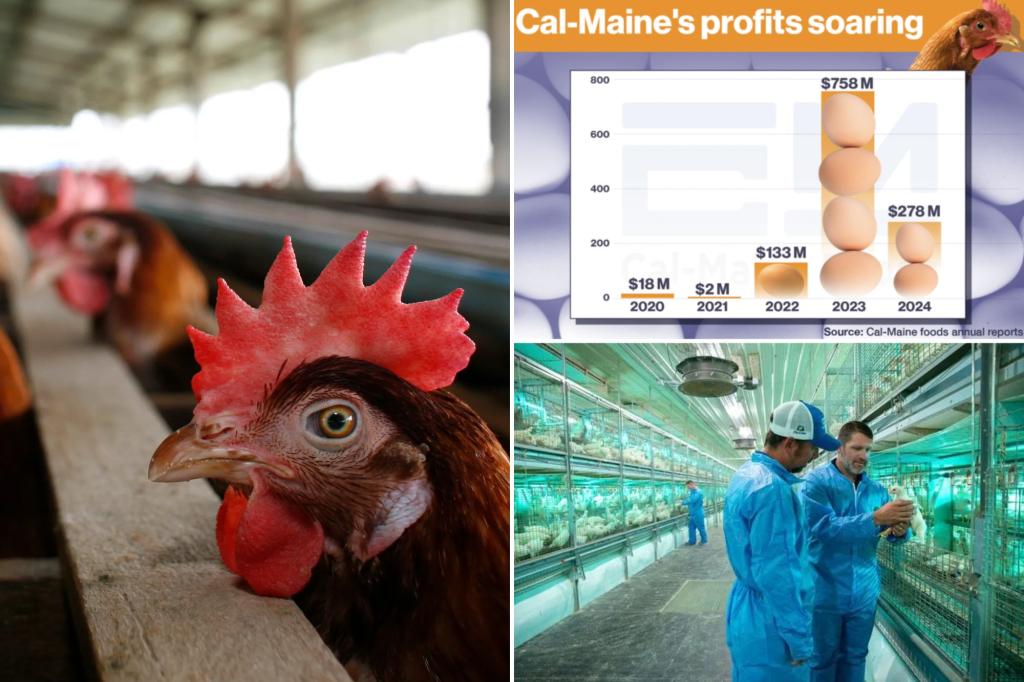America’s egg producers are making record profits while receiving tens of millions of dollars from taxpayers via the USDA for bird-flu related culls, The Post has learned.
Cal-Maine, the country’s largest egg producer, made $876 million net profit over the last nine months, it announced in April. The figure was five times the $164 million it had made in the same period during their 2024 financial year.
The profits are being driven by the continued sky high price of eggs for consumers — currently $4.60 per dozen — pushed up by birds being culled due to avian influenza.
Cal-Maine – whose brands include Land O’ Lakes and Egg-Land’s Best – said price increases were “a direct result of the reduced supply of shell eggs across the industry due to [avian flu] during a period of peak seasonal demand for eggs and egg products,” according to its quarterly report.
Publicly traded Cal-Maine, which has approximately 47 million laying hens, had to cull about 4% of its flock amid bird flu outbreaks, which started in 2022.
For each of those birds they receive between $15 and $17 per hen from the US Department of Agriculture (USDA).
The company temporarily shuttered one of its facilities in Texas last year, slaughtering nearly two million hens and receiving $21m in USDA money. A cull of 1.5m hens at one of its facilities in Chase, Kansas, the year before resulted in a payment of $22m, according to Inside Indiana Business.
Taxpayers have shelled out $1.25 billion in bird flu compensation payments since 2020 through to November of last year, according to the Federal Register.
Cal-maine isn’t the biggest beneficiary of USDA payments to date. Hillandale, one of the top five egg producers in the country with facilities in Ohio and Pennsylvania, received $53 million, according to the Washington Post. Another of the top producers, Versova, which has around 20 million hens at operations in Iowa and Ohio, has been allotted more than $107 million, according to the report.
Those companies areall privately owned and therefore not required to publicly disclose profit figures. Neither does Iowa-based Rembrandt Foods, which received $26 million in USDA payments when it was owned by billionaire Glen Taylor, according to local news reports from the time. It’s unclear whether Taylor still owns a stake, according to The Washington Post.
Angela Huffman, who is the president and co-founder of Farm Action – a group backed by smaller farmers to take aim at “corporate monopolies” – accused the egg producers of “corporate greed” for accepting millions in taxpayer-funded relief payments from the federal government while quietly breaking the bank.
“During [the early months of 2025 when Cal-Maine made $508 million profit], they were blaming high egg prices on losses from avian flu, which prompted USDA Secretary Rollins to commit one billion dollars to the egg industry,” Farm Action president Angela Huffman told The Post.
“There is no reason that the largest egg producer in the nation should be bailed out by our government while simultaneously tripling their profits.”
Ironically, the egg companies have been laughing all the way to the bank since the epidemic began. In the first three months of 2021, Cal-Maine made $359 million in sales. Four years later, its revenue has quadrupled — even though they only sold about 20% more eggs, Fortune reports.
Cal-Maine’s financial reports show it has been able to more than triple its average price for a dozen eggs, from about $1.30 before the outbreak to as high as $4.06.
However, the consumer pays even more – with American shoppers reaching a record peak of $6.23 for a dozen eggs in March, according to the Consumer Price Index.
According to Huffman, instead of using the windfall profits they are earning from the record egg prices to rebuild or expand their egg-laying flocks, the largest egg producers are using them to buy up smaller rivals and further consolidate market power.
Although Cal-Maine produces 90% of their own eggs, farms who have a contract to supply eggs to them are paid just $0.27 per dozen, per an investigation by Farm Action.
An investigation to alleged price-fixing for eggs has been launched by the Department of Justice.
In January, egg prices rose 15.2% — and the USDA predicts egg prices will increase at least another 41% this year, The Post previously reported.
In some New York City supermarkets, the price for a dozen regular eggs has hit or surpassed the $10 mark. Stores offering lower prices, including Trader Joe’s and Costco, have imposed limits on how many customers can buy.
“If taxpayers are going to subsidize egg producers for flocks lost to bird flu, then the least those companies could do is not price gouge consumers,” a source, who spoke on condition of anonymity, told The Post.
In a March letter to the Federal Trade Commission and Department of Justice, Farm Action claimed that Cal-Maine Foods has taken advantage of the avian flu crisis to “raise prices, amass record profits and consolidate market power”.
While US egg farms have destroyed some 115 million hens over 24 months to stop the spread of bird flu, the largest suppliers are showing “a remarkable unwillingness” to invest in expanding their flocks, according to the letter.
The group has accused leading egg producers are keeping the supply of new egg-laying hens “stagnant” in order to prolong their run of record profits.
The other companies accused of colluding with Cal-Maine are the four other largest egg producers, each with between 15 and 30 million hens: Rose Acre Farms, Daybreak Foods, Hillandale Farms, and Versova Holdings.
Cal-Maine did not respond to The Post’s request for comment.
The Trump administration has announced new measures to tackle bird flu including ramping up biosecurity measures and increasing the compensation paid out when infected flocks are killed.
The US egg-laying flock has yet to return to its pre-epidemic size of around 330 million hens.
During the last bird flu outbreak from 2014 to 2015, producers lost and replaced over 35 million hens in less than a year, making a full recovery from the outbreak. This time around, there is no recovery in sight after two years.
In 2023, Cal-Maine and three other egg producers were ordered to pay $17.7 million in damages by a federal jury after food suppliers accused the companies of conspiring to limit the egg supply in the US.
Read the full article here







